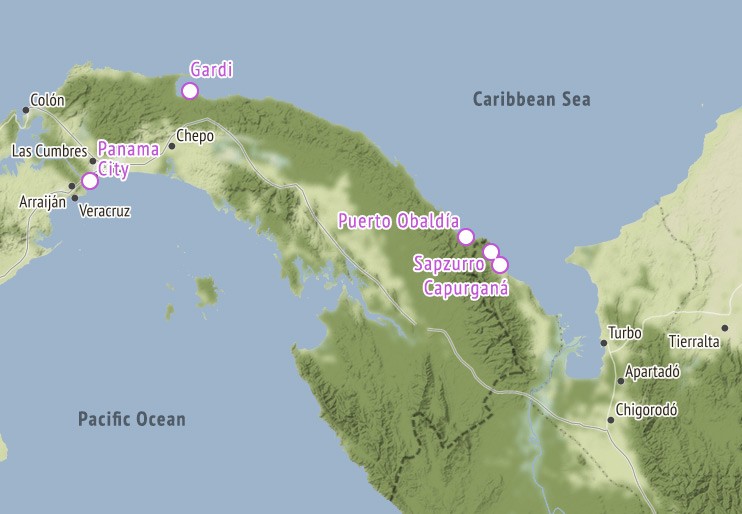
Adventure at the Panama-Colombia border
Part 4 of Biking through Colombia
Our destination is Colombia, but we got a big dose of adventure before even setting foot there. We wanted to arrive without flying, which meant getting up close and personal with the Guna Yala, a proud and independent Indigenous group that controls access to the only safe passage through the notorious Darien Gap.
We rode in a tiny boat down the Panamanian coastline, hopping the waves with the wind in our face. In an area known for FARC rebels and a dangerous jungle, we came face-to-face with a different, more pressing problem: Panama’s underreported refugee crisis.
16 April 2016
Panama City, Panama
Contrary to cultural expectation, our driver arrives at the hotel three minutes early. He eyes us up as we descend into the lobby, and tilts his head to motion us out the door. We throw our bags into the back of the Jeep and make a few more stops at hostels in the empty pre-dawn blackness. We’ve packed light — two bicycle panniers and a small day bag for the both of us. The ideal eco-adventure power couple; we sneer inwardly at the other tourists with their massive hiking backpacks and painstakingly curated iPhone playlists. Like them, we’re about to spend a vacation in Colombia. But we won’t be hitting up the gringo trail — we plan to buy some used bikes and cycle through the Andes for a month. But first, we need to cross the border.
Soon, the Jeep’s seven seats are filled to capacity. Like us, the other travellers are headed to the Caribbean coast to catch a boat en route to Colombia. It’s become a fashionable form of arrival as Colombia opens itself to international tourism: dozens of companies offer five-day sailboat cruises through the San Blas islands, an idyllic archipelago of white-sand beaches and palm trees.
Gardi Barkosun, Guna Yala, Panama
As the sun rises, the terrain becomes more mountainous and the road more rugged. We’re headed for Gardi (also known as Cartí), a collection of coastal settlements and islands in Panama’s Guna Yala province. Here, the local Indigenous people have tight control over their hard-fought territory, which spans most of Panama’s northern coastline and the picturesque San Blas islands. They control the only road that leads to the Caribbean coast, and we each pay $20 USD for the privilege of passing through. Our driver has a Guna flag dangling from his rearview mirror and seems to know everyone at the checkpoints. He speaks quickly and passes a handful of cash to the checkpoint guard, a young woman in full military dress and a gun slung across her back. Not everyone gets a receipt for the fare.
The steep terrain starts to drop, then levels out, and we arrive at Gardi Barsokun. It’s a sandy inlet fringed with mangroves. A half-dozen SUVs are parked in the dusty clearing, doors and trunks splayed open, as fellow travellers gather up their backpacks and water and sunscreen.
We walk past cardboard signs scrawled with the names of tour companies: LAM Tours, Iguana, Koala Adventures… but we’re not looking for a company name. We’re looking for a person called Negrito.
“Negrito” — this is our connection to onward travel. No reservation number, no pre-booked ticket, no clue of a schedule. Just a racial slur passed by word of mouth. Negrito. He’ll get us a ship to Puerto Obaldía, a tiny village on the border between Panama and Colombia.
You see, we don’t have the money or time to take one of these sailboat cruises, and we’re morally opposed to air travel. (I know, the self-righteousness is too much to handle.) Our digging around in the corners of the internet revealed the existence of lanchas, small passenger boats that zip from town to town along the coast. They don’t have websites.
Sure enough, someone perks up when they hear the name Negrito, and they usher us onto a water taxi. It’s a long, narrow aluminum hull with a shade canopy and an outboard motor. Julia and I are the only passengers. One man starts up the engine and begins steering, while the other hands us two lifejackets.
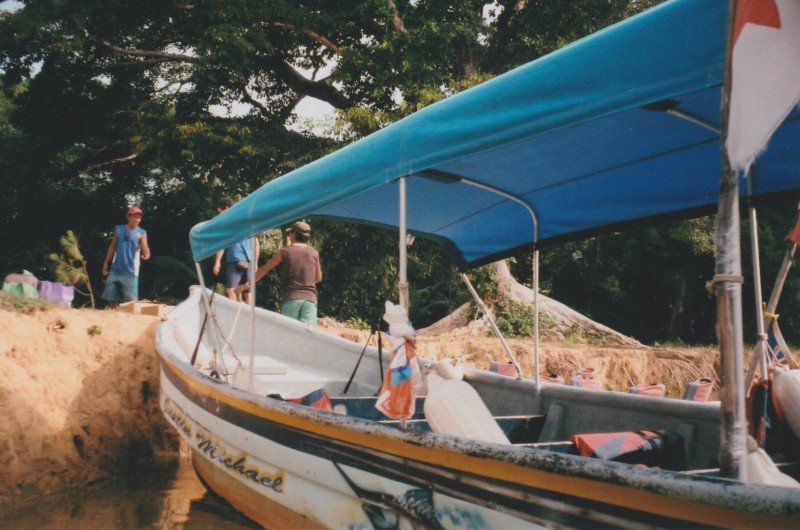
We cruise slowly through the mangroves, weaving our way out to the open water. The sea’s surface is punctuated by branches and logs — driftwood has gotten stuck in the mud. These must be very shallow waters. Some hazards barely peek above the waterline — they’re marked by ragged strips of white fabric, tied to sticks like a flag of surrender. It’s only a five-minute ride to Gardi Sugdub, an island just off the coast. Locals in dugout canoes paddle past us in the opposite direction, heading toward the mainland. They’re laden with jerry-cans of gasoline.
Gardi Sugdub, Guna Yala, Panama
We dock at Gardi Sugdub. This is Negrito’s place — the elevated dock leads to an enclosed patio of sorts, where three people are already waiting with their luggage. I can’t tell if the room we’re in is on solid ground, or if it’s sitting on top of stilts built out into the water. This island’s shore is a tight cluster of tin roofs, and it’s hard to see where the land ends and the water begins.
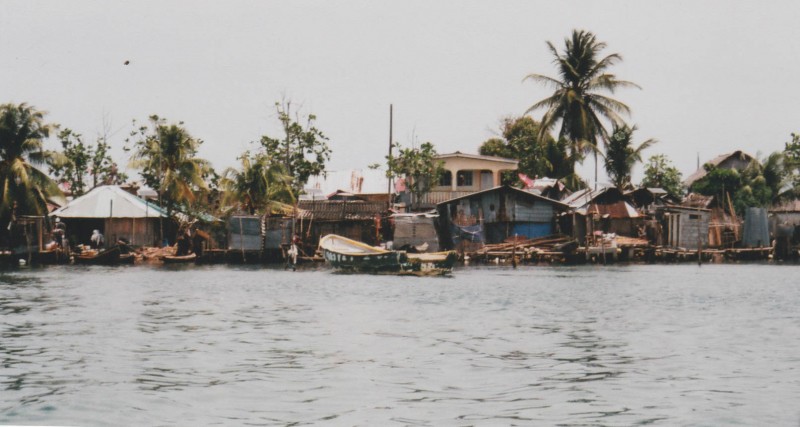
We’re in some kind of bar-restaurant-dancehall that apparently also acts as a waiting room for the lancha. On one wall, the words “Bar Matusalen” arc over a mural of a sunset and palm tree. The opposite wall loudly proclaims “Refresquería” above a closed serving window. The window is fringed with hand-painted illustrations of dancers, beer and soda cans. Down the hall, a small kitchen bears the inscription “Pizzería Don Thomas”. The name “Negrito” is spray-painted in bright orange, graffiti-style, on a closed door. Three times. So at least we know we’re in the right place.
Our fellow young backpackers have been swapped out for new, more experienced travel companions: Fabian is in his fifties, hair buzzed short to hide his balding. He sits at a table reading the newspaper and intermittently checks his phone. Theresa is a forty-something woman from Bolivia with wild-patterned leggings and a zebra scrunchie. She exercises pleasant patience and stands on the dock, looking out over the water. The third person waiting is José from Mexico. He cuts a clownish figure with his curly hair brushed back, long face, and bulbous nose. We go through introductions and pleasantries.
Fabian is Colombian, and he’s curious to see where we plan to travel in his native land. We pull out our National Geographic map, and all five of us pore over it. It’s amazing how a map — a real map, with folds and a legend and two sides that you have to flip between — encourages a kind of social interaction that GPS on your phone can’t match. Huddling together. Competing finger-pointing. Writing notes and highlights in the spaces between roads.
We expect Negrito will send his boat within the hour. It’s important to depart before 11 o’clock if we want to get to Puerto Obaldia before dark. Still, we figure we’ve got some time to explore Gardi Sugdub, so Julia and I set off down the tiny passageway connecting Negrito’s restaurant-bar-dock to the rest of the island.
We wind our way between walls made of lashed-together reeds. A wrinkled old Guna woman washes some clothes in a tub by hand, and we nod politely as we walk past. She doesn’t care about us. Children run about and scream as they do in every culture. We exit onto a street made of compacted dirt. We pass restaurants, shops, homes, most with tin or thatched roofs. There are no cars or bikes. Here on Gardi Sugdub, everyone walks.
Guna identity is strong here, with flags hanging from every other window. Their fierce textile patterns, so sought-after in Panama City’s art markets, are woven into everyday life.
We come upon a small window, beside which hangs a handwritten sign advertising drinks and snacks. We are greeted by Albert, who rises from his seat in the corner of the dark room with an over-the-top greeting: “Of course, it would be my great pleasure to serve you this morning!” He’s the talkative type. Big ears. Camo baseball cap. Shirtless, his ribs are visible through his skinny torso. His dark nipples point outward as if they are standing guard.
We buy a couple bottles of water and I drop two dollars’ worth of small change into his hand. Albert miscounts the change, asks for another 25 cents, and I comply. At this point he’s already in the swing of conversation with Julia. They discuss where we’re from — “It’s very cold in Canada, yes?” — where he’s from — “There are two, three thousand people here on Gardi Sugdub.”
We learn that the revenues from the Panama Canal help fund a stipend for indigenous people, and Albert says he gets about 120 Balboas (equal to $120 USD) per month from the government. It helps, but it’s not enough to live on. He points to the handmade textile bags for sale, the two bottles of water we just bought, to assure us that he does brisk enough business to make up the difference.
Albert is fiercely proud of his Guna heritage. He laments that the culture is being lost, bit by bit, but with so little urgency it’s as if he realises this is just a thing older people of every generation say. He explains the meaning of the Guna flag that we see all around the island — a red stripe to represent blood, a green stripe at the bottom for the land — the long, mountainous coastal strip called Guna Yala. In the flag’s centre, a pair of crossed muscular arms hold a bow and arrow. This represents the struggle of the people. Stars surrounding the arms represent the cosmos. And perhaps the islands, I’m not sure. I can’t remember what the yellow background in the middle represents.
A little worried about missing Negrito’s boat, we gratefully say farewell to Albert. He points us to a house a few doors down there we could spend the night if our boat doesn’t come today. Negrito’s “hotel” does not have the best reputation around here. With more thanks, we turn back toward the dock.
The situation hasn’t changed much. The clock is ticking toward 10:30 am, and our lancha hasn’t arrived yet. The five of us bide our time a little further, each minute bringing increased uncertainty. Would the boat come? Would we leave the island today? Our new friends — Theresa, Fabien, and José — were promised a boat yesterday. It didn’t come, and they were obliged to spend the night at Negrito’s “hotel”, which costs $5 USD a night. From what we hear, the scare quotes are well-justified.
Julia and I hadn’t had any breakfast, and were quite hungry. On our trip to see Albert we had passed a large open restaurant, and we decide to get something to eat. Fabien says he’ll make sure the boat doesn’t leave without us. As we step back out toward the street, we are stopped by a man in a teal golf shirt headed the opposite way. He asks is if we are travelling with Negrito, and ushers us back to the bar. Something is amiss.
Theresa and José come in from the dock. Fabien looks up from his phone. Julia and I stand in the middle of the room, arms crossed (as is our North American duty — I don’t think I’ve ever seen a Latin American person stand with their arms crossed).
“Negrito says the motor is broken. He’s trying to fix it, but it should be ready by tomorrow.”
Immediately, the Spanish starts flying. Dismay, disappointment, soft shaking of heads. No anger or insults, as this is a civil group of folks. Finally, Fabien cuts to the heart of the matter: “Your boat isn’t broken, you’re just waiting for more passengers — isn’t that right?” Negrito’s messenger slips, nodding his assent with a pained face. He leaves the room, noncommittal, sticking weakly to the broken-engine story.
This throws our whole room into a heightened state of uncertainty. Maybe we should go back to the coast, find another boat to take us. Nobody wants to stay another night and pay five dollars for Negrito’s sorry excuse for a hotel. He’s just playing us. Maybe now that we’ve called his bluff, he’ll leave today after all. Maybe if we start looking for someone else to take us, we can force Negrito’s hand. A group of five willing travellers is a useful bargaining chip. We weigh our options. Consider, ponder. The day seems lost at any rate, we should have left by now, otherwise we risk getting caught out at sea after dark. It’s an 8-hour trip to Puerto Obaldía.
Amid the consternation, one of my favourite early-2000s hip-hop songs floats in from the dock. It’s Eve’s Let Me Blow Ya Mind. A fresh-faced young black man is blasting it from his phone. He’s sitting in a lancha. Two young Panamanians — couldn’t be older than eighteen — hop out of the boat.
“Let’s go, boat’s leaving.” Just like that.
We hand over the requisite $125 USD each. So does Fabien. Theresa hands over $100 — “Cien, es OK?” José has a hushed, animated conversation with the boys. “Did Negrito tell you about my situation? I’m not a tourist, you see…” He pays $60 and the boys carefully consider the sum of money. They’ve got commissions and fees to think of. A cut to Negrito, a cut to the port authority… After a quick phone call, they seem satisfied. We’re off, bags thrown in the front of the lancha, covered by a tarp. They hand us lifejackets and the twin outboard motors roar to life.
San Blas islands, Guna Yala, Panama
There are six of us, plus two crew members. We fit comfortably in the five rows of bench seating. It’s a fibreglass hull with a fabric canopy, identical to the water-taxi except for extra cushions on the previously-bare wooden benches, worn blue-painted slats for backrests, and swapping out the water taxi’s 15hp engine for two 75hp workhorses.
We pull out of the dock and start hitting the waves. By hitting, I mean a spectacular bellyflop that sends a jolt through each of my vertebrae every time we crest over a wave. Immediate headache. I hastily stow my glasses in their case to prevent them from being knocked into the Caribbean Sea. Maybe it was a good thing that we didn’t go eat lunch.
It’s a cloudy day, and the sea is steely grey crashing all around us. The coast of Guna Yala to our right, jungle mountains shrouded in mist. Every couple kilometres, smoke rises above the trees. Fabien says they’re burning away forest to make room for crops. I’m not sure I believe him. To our left, the San Blas islands. Tiny clumps of palm trees, ringed with white sand, the platonic ideal of a desert island. These islands are dotted along the vista, awkwardly breaking up the surface of the sea. They somehow seem like they don’t belong. On the smaller islands, the palm trees look sad. Wind-stripped, hunched over. Bamboo and thatched-roof Guna houses dot the shorelines of the larger islands. From afar, San Blas looks like a set of petri dishes all plunked on top of the churning, swirling, unforgiving sea. Jolt. Thunk. The lancha rides on. It feels like falling down an endless flight of stairs. The sea swells around us.
From up close, the islands appear much like Gardi Sugdub — our boat stops at some of them and they seem quite populated, ringed with docks. Gasoline cans in haphazard stacks. People in small fishing canoes a hundred metres off the coast, casting lines and diving. We dock at an island called Carganá to drop off a box of bananas and some motor oil. Fabien hops out and returns with chips and Coca-Cola for us all. Our little troupe of sea-faring travellers are starting to build a bit of camaraderie.
Juan Carlos is the hip-hop-loving young man who was first aboard the lancha. He owns two seafood restaurants in Colombia. He smiles a lot, talks rapidly and is eager to make conversation.
Fabien owns a Koala Tours, a tour company that arranges sailboat crossings from Panama to Colombia. Two of the people we met in the morning Jeep ride are on one of his boats by now. Fabien is on this rickety lancha ride because he wants to check up on a houseboat he owns in Sapzurro, a small coastal village just past the Colombian border.
Theresa, originally from Bolivia, built up a restaurant business and owned two houses in Medellín before leaving for Panama a year ago with her savings, trying to make a better life for herself. It proved more difficult than expected. She ended up selling bottled water in the street to make ends meet. Now she’s heading back to Colombia, trying to start anew once more.
José was an upholsterer in Mexico — at the peak of his career, he worked near the U.S. border making seats for airplanes. The work dried up, and now he’s sixty and exhausted, lugging along an enormous sewing machine which represents his greatest store of value and the means by which he can ply his trade. He too is looking for work in Colombia.
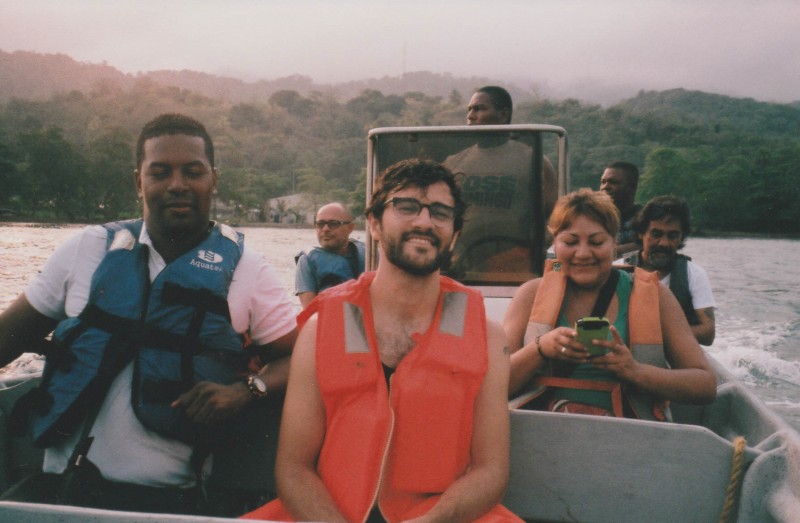
Continuing along the coast, we don’t drop off any more packages, although we make two more stops. At a place nicknamed “the Island of Dogs”, we dock briefly to use the bathroom, as the sun nears its apex behind a cloudy sky. The cloud cover belies the sun’s heat — Julia, sitting on the right side of the boat, hasn’t noticed her whole right arm, face, and thigh turn red.
After a couple hours, we veer toward a small port on the mainland. There is a large black mass ahead of the boat just below the water’s surface — a coral reef. As we approach, the driver expertly manoeuvres in and out, zig-zagging through the shallows all while maintaining speed. The bay is full of coral. If our lancha were any larger, I doubt we could enter that bay at all. The captain docks, barely, one foot straddling the pier. He hands a wad of cash to another man who was waiting there. They exchange a jovial greeting, then we’re off again.
Wave-jumping is hard work. But sooner than I had expected, the motor slows to a comfortable cruising speed, matching the waves’ rhythm instead of overtaking them. We pull into another bay, where a large military banner is draped over the fence beside a small hut. This is Puerto Obaldía, our last stop in Panama before crossing the border to Colombia.
Puerto Obaldía, Panama
The internet warned us that Puerto Obaldía’s immigration office closes early, and that we’d be stuck in this “shabby little town of nothing” for a night, while we wait until morning to get our exit stamp. But Juan Carlos, full of restless energy and unwilling to take no for an answer, tries to turn the tables in our favour.
After getting through the military checkpoint, we find ourselves on the main street of Puerto Obaldía, our luggage in a pile around us. Juan Carlos spies a young kid hanging out on the street corner and whistles him over. “Go find me the man who runs the immigration office.” He slips the kid some money.
Juan Carlos bribes a government official and gets him to open up the office and stamp our passports for exiting Panama. We’re all moving in a herd now, loosely following Juan Carlos, united by a desire to cross into Colombia today rather than tomorrow. The lancha is supposed to be waiting for us — Juan Carlos talked with them. They’ll take us on to Capurganá tonight for another $10 USD per person.
Naturally, José and Theresa won’t have to pay. The four of us wealthier travellers — Juan Carlos, Fabien, Julia and myself — have created a de facto welfare state within our group of rag-tag travellers. Fabien, the mature, successful businessman, willingly takes on the lion’s share. He got to know José and Theresa before the rest of us, and spent a night with them in Negrito’s godforsaken accommodations. Noblesse oblige is alive and well here in Latin America.
Despite our best efforts, all this running around turns out to be for naught. The lancha is gone. It’s past 5 o’clock, and getting dark — nobody in town is willing to take us across the border. The guards at the military checkpoint have fun taking their time re-checking our bags, bringing out the drug dogs, all so we can walk out to the pier and realise we don’t have a boat. One guard jokes, “Why would you want to leave this paradise town? We have five-star hotels. Stay the night!” So we do.
Far from a “shabby little town of nothing”, Puerto Obaldia is full of activity. As it turns out, this seaside village is the flashpoint for the latest immigration crisis in the Western hemisphere. Apparently, Panama recently loosened its entrance requirements which prompted a flood of Cubans, Haitians, Ghanians and Nigerians toward the Panamanian border. Once here, they can apply for refugee status or continue North to Mexico and, eventually, the USA. On the ground, this means hundreds of makeshift tents behind the soccer pitch in Puerto Obaldia. Apparently there are Cuban aid groups sending them food, which is a good thing because this town’s pantries seem to be bone dry.
Resigned to spending the night here, we search high and low for a restaurant. Club music booms from a billiards hall facing the soccer pitch. All we can find in the immediate downtown is beer and Coca-Cola. We follow a trail of recommendations to the end of the street — no, to the end of that street — no, around the corner — to a well-lit patio on the edge of town. A TV is on, showing a feature interview with Bernie Sanders’ Hispanic Press Secretary. It’s the only place in town where people are sitting down to eat.
We take a seat at a long table where two Ghanians are finishing up their meals of meat, rice, and soup. We strike up a conversation with Isaac, who ran an import-export business selling car tires; he says Ghana would be a good place to live if it weren’t for the corrupt government. He moved to Brazil two years ago and worked for a year as an airport security guard. However, his visa was revoked when the Brazilian government decided that airports should only be staffed by Brazilian nationals. Now he’s trying to make his way to the USA where he has some family. He’s aware of the immigration crisis. He’s aware that there are still 9 borders to cross. But he says, “God will find a way.”
Miracles. Everybody’s waiting on them, including our group of six. The restaurant owner has just informed us there is only enough meat and rice for two more portions. We ask her to just make whatever she has on one large platter; we’ll share. Not quite Jesus’ loaves and fishes, but we make do. Julia and I pay for the meal ($14 USD), a token of thanks to the group for getting us through this day.
Isaac puts down his fork, says his goodbyes and pushes away his chair. As he leaves, I realise he didn’t finish the rice on his plate.
17 April 2016
Capurganá, Colombia
We get up at the crack of dawn and pay a premium for the early-morning lancha to Capurganá. Juan Carlos is calling the shots again; he is very eager to make it to Turbo, Colombia (where one of his restaurants is located). In his mind, we’ve already lost a day. We all tag along, since I guess we’re a posse at this point. Ten minutes of motoring later, and here we are. The little port of Capurganá — not militarised like Puerto Obaldia. Beachfront restaurants. Diving tours advertised on the side of boats. It being a Sunday, the Colombian immigration office doesn’t open until 10 o’clock, so we can’t get our Colombian entrance stamps yet. Strike one against Juan Carlos’ breakneck pace.
We’re all famished from the day before, so breakfast is in order. We set our bags down, relieved at a spot of respite — we hadn’t slept well last night at the local pension, between the night-long thump of music and the hard straw-filled mattresses. We order watery café tintos all around, and gorgeous, piping hot arepas con huevos — an egg smothered in oily deep-fried cornmeal. Hot sauce brings it to the next level.
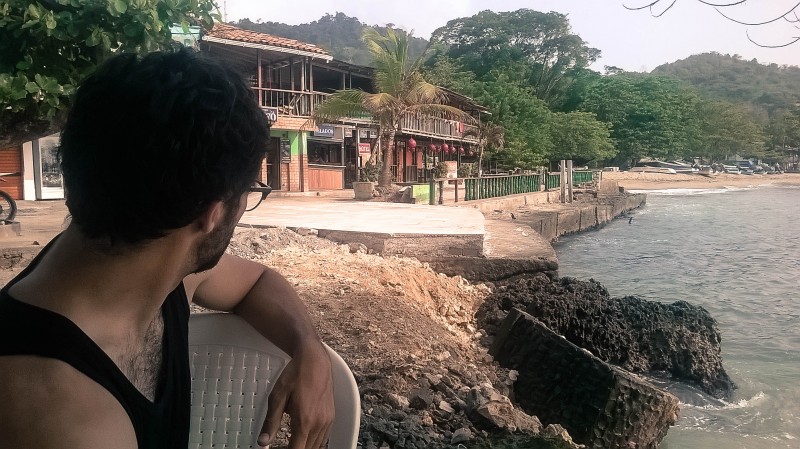
We’re only in Capurganá for a couple short hours before we hop on another boat to Sapzurro, the neighbouring town. It’s back the way we came — Capurganá is actually the second town south of the border. But Sapzurro doesn’t have an immigration office, hence the back-and-forth. Fabien has his houseboat moored in Sapzurro, and offers to host Julia and I for as long as we want. A day or two of rest in a houseboat sounds fantastic. Fabien is getting a little overbearing, but he’s so generous that it’s impossible to stay annoyed. Still, everything is a whirlwind with him. We make for the dock, saying hasty farewells to Theresa and José (Juan Carlos has already left for Turbo).
This boat is not a simple lancha. It’s longer, wider, and filled to over-capacity with fifty West Africans in lifejackets — migrants headed north to the Panamanian border. I wonder if Isaac is somewhere in the crowd. Sapzurro is the last town on the Colombian side, after which they will be on their own, trekking through the jungle for three days to reach Puerto Obaldia. Unlike us, they can’t take a boat across the border — the military checkpoint won’t let them through. So they have to go in through the back door.
I wasn’t expecting for us to be brought along in the swell of migration — even here, where we saw the tent city, where we knew the migrants had been coming for months, somehow I deluded myself into thinking this was still a problem happening elsewhere. That, as a tourist, I’d be exempt from witnessing the troubling human desperation of a refugee crisis.
Sapzurro, Colombia
It’s only a five-minute boat ride to Sapzurro — we all get off, each of the migrants clutching their possessions bundled in a black garbage bag. Julia and I collect our packs and head off down the beach to where Fabien’s houseboat is docked. A brief brush with the migration crisis, and now we are back to our vacation.
Sapzurro is tiny — less than half the size of Capurganá and nestled more tightly between the jungle-covered mountain and the sea. We’re to stay in Fabien’s houseboat (nicknamed Sofia) with Robbie and his mother, Maria, as our hosts. Robbie has been watching the boat while Fabien is gone. He used to be a sailor (still is, I suppose). He has an impressive arm tattoo and invites us to help empty his bottles of whisky and red wine as we sit on the upper deck that evening.
I’m quite nauseated being on the rocking boat all night, and don’t have as much fun as I thought I would — instead, I find myself tuning out the Spanish and zoning in to the top-40-from-ten-years-ago video playlist Robbie had put on. It seems Latin America just doesn’t do silence. Pop music must always be playing.
That night, I sleep in a rocking houseboat to the sound of crashing waves, as fifty West African migrants push on through the dark in a thick, tangled, foreign jungle that is not their friend, to the border of a country without the capacity to welcome them. I count myself very lucky.
Sapzurro is so isolated, but so hemmed in at the same time: by the ocean, by the mountains, by the jungle, by the border. This gives it a frantic energy, a dull anxiety that seeps through everything.
Like in Puerto Obaldia, it is hard to find food in Sapzurro. We seem to only have the option of one restaurant being open at a time, and fresh fruit is expensive. We buy a few apples for Robbie and his mother as a thank you gift for hosting us.
18 April 2016
Sapzurro, Colombia
In the morning, we discover a secret of the jungle — a wealth of tasty fresh fruit literally falling all around us. We’re taking a hike back to Capurganá, bags in tow, Robbie guiding us, his mother taking up the rear in her sun hat and floral Crocs. It’s a steep mountain trek, as Sapzurro and Capurganá are in neighbouring valleys. The whole thing takes about an hour and a half, and we are rewarded with a splendid vista — Sapzurro to our left, Capurganá to the right — when we reach the peak. We pick fresh ripe mangoes from the ground, and they are decadent. They have a certain acidity that the ones back home don’t have, and they are more stringy. We collect avocados too, a whole grocery bag full of them. We find a starfruit tree and Julia knocks one down, to save for later.
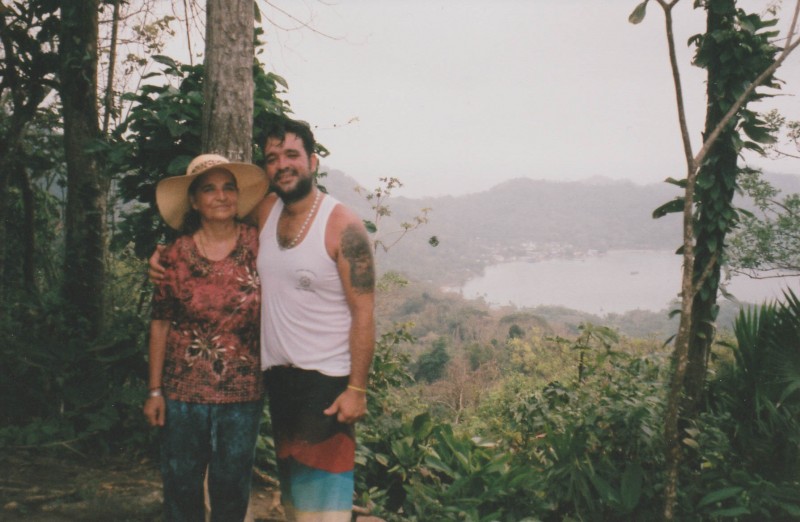
Capurganá, Colombia
The morning mountain trek has stirred our appetite. Robbie shows us to a bakery in Capurganá, just off the soccer field, where we munch papas rellenas for breakfast — a hard-boiled egg wrapped in potato and deep-fried. Deep fried food seems to be a theme here in Colombia.
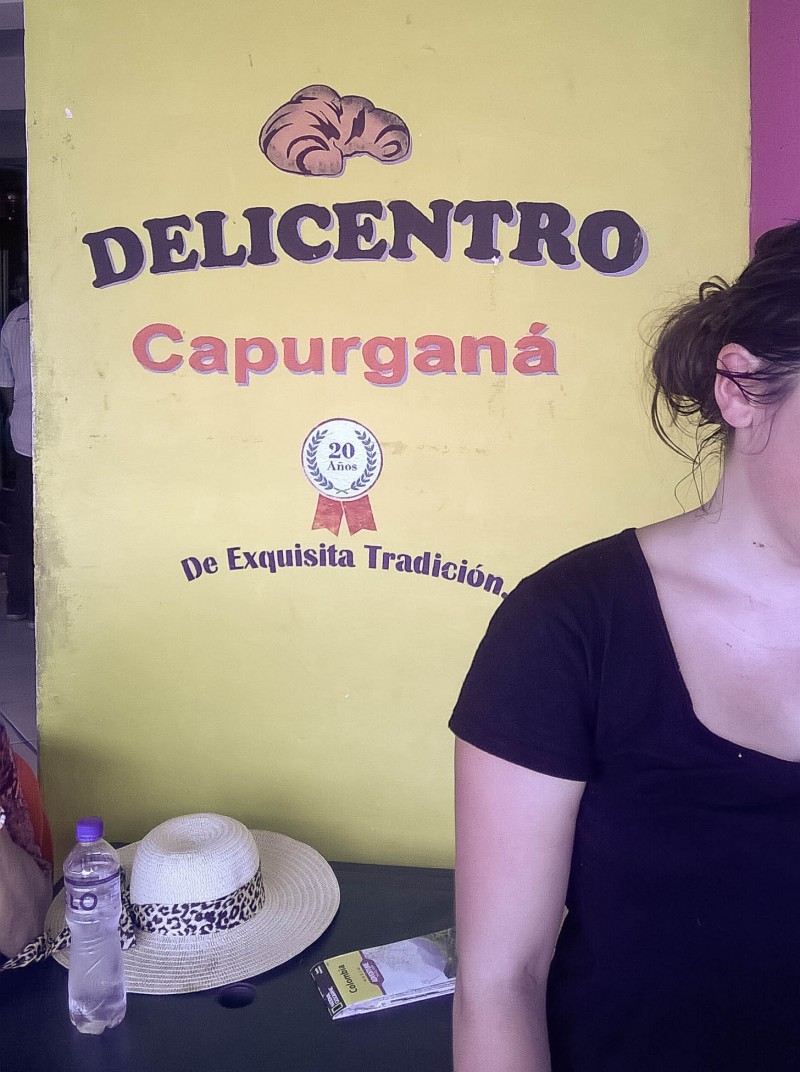
Having parted ways with Robbie, we book a boat headed for Necoclí, where we will buy some used bikes and start our “real” Colombian adventure. We hadn’t counted on such a stimulating three days crossing the border.
The boat doesn’t leave until tomorrow, so we’ve booked a room in a cheap hostel, trying in vain to dry out our clothes in the damp seaside air. In the evening, we have a couple beers at the beachside Lonely Planet-recommended bar, Josefina’s.
It’s been an uncertain, sometimes stressful few days here on the doorstep of Colombia. But now I feel ready for anything. Tomorrow, we go inland.
Sam Nabi
Comments
I smiled at your group excitedly hovering over the map. So many choices for life changing experiences. You are a master of being in the moment - and also at writing about it.
Post a comment